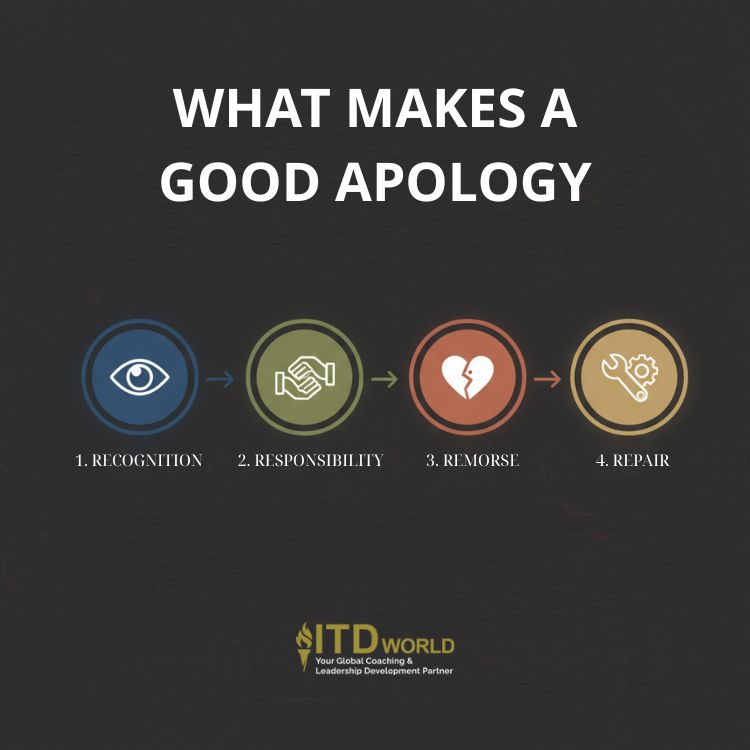A practical guide to understanding the power of apology, delivering it with impact, and following through with integrity.
Trust is the ultimate currency of leadership, and it is built on a foundation of accountability. When a leader makes a mistake (as all eventually do) the most impactful tool they have for repairing – and even deepening – that trust is a sincere apology. It is a direct and unambiguous signal to the team that they value the relationship more than their own ego – and are committed to a culture of integrity. Below, we will explore practical strategies for leaders to harness the power of apology, transforming missteps into opportunities for growth and stronger team bonds.
|
Author: Jonathan M. Pham |
Highlights
- Admitting one’s mistakes is a strategic act of courage that rebuilds trust, models a growth mindset, reduces conflict, boosts morale, and reinforces a culture of accountability and collaboration.
- A powerful apology, following the 4Rs formula, requires a mindset focused on the impact of one’s actions, and must include Recognition of the specific wrong, taking Responsibility without justification, expressing genuine Remorse for the impact, and committing to Repair through changed behavior or making amends.
- The primary challenges to apologizing for leaders stem from ego-driven needs to be “right,” a fear of judgment, and a mistaken belief that apologizing diminishes authority.
- To deliver an effective apology, leaders should prioritize timing (sooner rather than later), choose the appropriate modality (in-person for significant issues), and select the right location (private for individuals, public for systemic issues). It is recommended that they follow through with Marshall Goldsmith’s “Magic Move” – apologizing, advertising the commitment to change, and consistently following up for feedback – while also respecting the other person’s feelings and focusing on sustained behavioral change.
Why is an Apology Powerful?
Traditionally, the act of saying sorry was often interpreted as a sign of weakness in leadership – an admission of fallibility that could undermine authority. However, in the modern workplace, such a view is not only outdated, but extremely dangerous. In fact, a sincere and timely apology is not a liability; it is a strategic act that requires a high degree of emotional intelligence, courage, and strength.

The power of apology
The benefits of this simple practice far outweigh the perceived risks:
- Rebuilds trust & psychological safety
Trust is the foundation of any effective team. When a leader apologizes, they validate their team’s experience and take ownership of their impact. Their act makes a significant deposit into the team’s “trust bank” and is a cornerstone of psychological safety. It sends a clear message: “It is safe to be honest here, and we can address challenges without fear of blame.”
- Models a growth mindset & encourages innovation
By openly admitting their wrongdoing, a leader models that errors are opportunities for growing, not something shameful to be hidden. As such, they encourage a growth mindset throughout the team, where individuals are more willing to take the smart risks necessary for innovation, knowing that an occasional misstep will be treated as a learning experience.
- Reduces conflict & boosts morale
Unaddressed mistakes and hurt feelings do not disappear; they fester, leading to resentment, disengagement, and conflict. A timely apology demonstrates empathy and respect for the team’s feelings. It can instantly de-escalate a tense situation and serves as a powerful morale booster – by showing that the leader recognizes the importance of their people and the relationship.
- Reinforces a culture of accountability & collaboration
When a leader holds themselves responsible for a mistake, they set the standard for the entire organization. In doing so, they demonstrate that accountability is a core value that applies to everyone, regardless of their position on the organizational chart. Such an example is far more impactful than any mission statement or poster on the wall.
Conversely, failure to apologize essentially sends a message that passing the buck is an acceptable survival tactic. Over time, this will gradually lead to a toxic environment where problems are hidden, finger-pointing is common, and genuine collaboration is impossible.
Read more: Leading by Example – Key to Truly Inspiring Action & Trust
The power of apology
The Anatomy of a Powerful Apology: The 4Rs Formula
Not all apologies are created equal. Quite often, a poorly constructed or inauthentic one will only do more harm, adding insult to the original injury. As such, one must start by adopting the right mindset.
The most critical principle is to focus on the impact of one’s actions. While your intentions may have been good, the apology is not about you or your feelings; it is about acknowledging and validating the other person’s experience. Hence, it is essential to demonstrate empathy for the impact you have caused.
Typically, a sincere, complete, and effective apology should address key components: Recognition, Responsibility, Remorse, and Repair.
- Recognition: Clearly and specifically stating what you did wrong. For this purpose, one needs to use direct language and avoid passive phrasing like “mistakes were made.”
Example: “I recognize that I interrupted you multiple times in the team meeting while you were presenting your data.”
- Responsibility: Taking full, personal ownership for your actions with “I” statements – without any justifications. One common mistake many leaders fall prey to is adding words such as “but”, “no”, “however”, etc. A phrase like “I’m sorry, but…” is an excuse, not an apology, as it attempts to shift blame.
Example: “That was my mistake, and I take full responsibility for it.”
- Remorse: The heart of the apology, where you express genuine regret for the negative impact your actions had on the other person.
Example: “I am genuinely sorry for the frustration and disrespect my interruptions caused you.”
- Repair: The forward-looking component that proves what you say is not just empty words. It involves stating your commitment to change your future behavior and, where appropriate, offering a way to make amends.
Example: “In the future, I will be more mindful and ensure I let my colleagues finish their thoughts. To make it right now, I would like to schedule 15 minutes for you to walk me through the points I cut you off from.”

The power of apology
The Power of Apology: Examples in Action
When the 4 R’s above are combined, the result is a powerful and restorative communication.
- Effective apology:
“I’m acknowledging my oversight in not including your team in the planning phase, and I sincerely apologize for the extra work it created for you. I’m committed to preventing this from happening again. What steps can I take now to best support your team?”
Why it works: It contains clear Recognition, takes Responsibility, expresses Remorse, and moves directly to Repair.
- Ineffective apologies:
“I’m sorry if you felt that way.” (This is a conditional non-apology that questions the other person’s feelings).
“Mistakes were made.” (This uses passive voice to avoid taking any personal Responsibility).
“I’m sorry, but you have to admit the deadline was unreasonable.” (This involves an excuse and shifts blame, destroying sincerity).

The power of apology
Challenges of Apologizing
- The need to be “right”
A leader’s ego is often tied to their sense of competence and correctness. An apology can feel like a direct threat to this self-image, triggering a powerful, instinctual need to be right and to defend one’s position at all costs.
Solution: Reframe the goal from “Winning” to “Connecting”. As leader and author Mark Matthews once noted, “Apologizing does not always mean you’re wrong; it just means you value your relationship more than your ego.” The goal of a leadership apology is not to “lose” an argument, but to win back the trust and alignment of your team. By consciously shifting your goal, you will gradually be able to bypass your defensive reaction.
- The fear of being judged
The act of saying sorry requires vulnerability. It involves admitting an imperfection and opening yourself up to the judgment or criticism of others. This can feel particularly risky for leaders, who often feel the pressure to project an image of infallible strength.
Solution: Understand that vulnerability is the gateway to trust. Authentic trust cannot be built on a foundation of perfection; it only comes when a leader has the courage to be real. In doing so, you demonstrate that you are a human being who is committed to growth – and create a safe space for the team to be vulnerable in return.
- The misconception of authority
A persistent myth in some traditional management cultures is that a leader who apologizes is showing weakness.
Solution: Reframe apology as the ultimate sign of confidence. In reality, it takes immense strength, self-awareness, and confidence for one to admit a mistake and take ownership of it. A leader who is too insecure to admit their own faults is the one who is truly weak. On the other hand, having the courage to say “I was wrong” shows a level of integrity and strength that commands genuine respect and deepens one’s authority, rather than diminishing it.
Read more: Ego in the Workplace – The Hidden ‘Evil’ Behind Team Dysfunctions
The power of apology
The Leader’s Playbook for Apologizing
Delivering the apology
- Timing: Sooner, not later
A timely apology demonstrates a high degree of self-awareness and respect for the other person. Delaying it, whether due to ego or fear, allows resentment to accumulate and only makes the situation worse. As such, it is crucial to resolve the issue as soon as you realize a mistake has been made.
- Modality: In-person is most powerful
For any significant mistake, addressing it face-to-face is non-negotiable. It demonstrates courage and gives you the chance to convey sincerity through your tone and body language. A written apology (e.g., via email) may be appropriate for less severe issues or can serve as a thoughtful follow-up to a verbal conversation, but it should not be the primary method for serious matters.
- Location: Private for personal, Public for systemic
Example (Private): If your action has negatively impacted a single individual, the apology must be delivered in a private, one-on-one setting. This shows respect for their privacy and allows for a more candid and personal conversation.
Example (Public): If your decision has affected an entire team or department, a public apology in a group setting is often necessary. Doing so demonstrates accountability to the whole group and ensures everyone hears the same message of ownership and commitment to repair.
Read more: Thoughtful Leadership – Why It Matters in Today’s Hectic World

The follow-through: Marshall Goldsmith’s “Magic Move”
Saying sorry is the first step, but what truly makes it a leadership tool is the commitment to lasting behavioral change. Renowned executive coach Dr. Marshall Goldsmith, in his book “What got you here won’t get you there,” outlines a three-step process for making an apology stick as follows:
- Apologize: Offer a sincere and complete apology for the specific past behavior, using the 4 R’s framework above.
- Advertise: Openly state your commitment to changing that specific behavior. For example, a leader might say to their team, “I know I have a habit of interrupting people in meetings. I am committed to being a better listener, and I am going to work on this.”
- Follow-up: This is the most powerful and often-skipped step. Specifically, one must consistently check in with their team and ask for feedback on their progress. For instance, after a few weeks, the leader might ask, “How have I been doing on my commitment to listen more in our meetings?” As simple as it is, such an act creates a powerful accountability loop and proves that the commitment to personal transformation is genuine.
Read more: Leadership Feedback – The Key to Changing for the Better
After the apology: Navigating the response
Once the problem has been authentically admitted, you must give up control over the outcome. Your job is to own your actions; how the other person responds is their choice.
- If the apology is accepted: Express gratitude for their grace and immediately shift the focus to the “Repair” step. Your future actions are what will truly rebuild and solidify the trust.
- If it is not immediately accepted: Respect their feelings. Do not become defensive or say, “But I apologized!” Simply state, “I understand it may take time. I want you to know my apology is sincere, and I am committed to earning back your trust through my future actions.” The key is to remain patient and focus on change.
It’s worth mentioning that there is typically a “Dumb” phase (a term coined by Marshall Goldsmith) – the critical period after you’ve started to change but before others have started to notice. It’s like turning a large ship; the rudder changes direction long before the bow of the ship visibly turns. During this phase, you must have the patience to continue demonstrating the new behavior consistently, even if you don’t get immediate positive reinforcement. Over time, your consistent actions will overcome their perception.

The power of apology
The Power of Apology Quotes
An apology is the superglue of life. It can repair just about anything.
Brynne McWherter
Never ruin an apology with an excuse.
Benjamin Franklin
Mistakes are always forgivable if one has the courage to admit them.
Bruce Lee
A sincere and warmly-expressed apology can produce the same effects as morphine on a suffering soul.
Jessica Mitford
When you forgive, you free your soul. But when you say I’m sorry, you free two souls.
Donald L. Hicks
How ITD World Can Help Establish a Culture of Accountability
Leading with the courage to apologize – and the skill to do it effectively – is a hallmark of a mature, emotionally intelligent leader. It is a core capability that underpins a healthy, high-accountability culture where teams feel safe, respected, and motivated. Cultivating it – along with other competencies – is a key focus of modern leadership development.
At ITD World, we specialize in enabling leaders and organizations to acquire the capacities needed to build high-trust, high-performance environments. Our solutions are designed to move beyond theory and provide the practical tools and expert guidance to make accountability and psychological safety a reality in the workplace.
- Executive coaching: Our one-on-one executive coaching provides a confidential and supportive space for leaders to foster the deep self-awareness and courage required to own their mistakes, process feedback, and practice vulnerability.
- Training workshops: Our targeted workshops focus on the core competencies that enable effective apologies and accountability, including Emotional Intelligence, holding difficult conversations, etc.
- Customized in-house solutions: We partner with you to design bespoke programs that contribute to the establishment of a true culture of accountability, aligning your leadership behaviors and communication practices with the values of trust and integrity.
Ready to transform challenges into opportunities for growth? Contact ITD World today to learn how our solutions can help!
Other resources you might be interested in:
- Humble Leadership: The Quiet, Often Forgotten Powerhouse
- Compassionate Leadership: Beyond Simply ‘Being Nice’
- Cross-Cultural Communication: Guide for Leaders & Managers
- Leading With Impact: Translating Your Presence Into Performance

